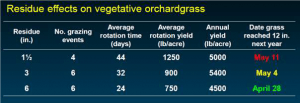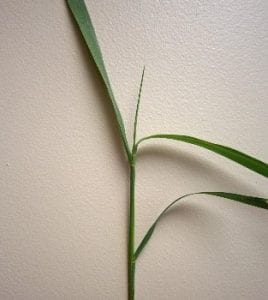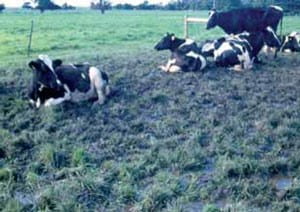Every year it’s a game of hurry up and wait. In March, the pastures started to green up and thoughts of an early spring and early grazing turn out came to mind. However, by the end of April we had dipped back to being chilly, snow blanketed parts of the county, and 3 inches of rain was in the forecast. So when will we be able to turn out our cows, sheep, or goats. That answer is, it’s complicated.
From the plant’s point of view, the three-leaf phase is where the grass plant wants to be. The grass tiller or stem has grown to the point of having three leaves with a collar developed around the stem, like the collar of a shirt. At this stage, the grass plant has grown to the point where it has replenished its reserves and is getting most of its energy to grow through photosynthesis. At this phase of growth, the grass plant will be able to tolerate grazing and not be stunted when grazed correctly. It is important to leave enough solar panel, residual grass left after grazing, so that regrowth happens quick and the plant doesn’t have to use its reserves to push new growth. Residuals of 3-6 inches will allow you to start grazing earlier the following year and shorten rotation times. Figure 1 shows the variations in grazing management with orchard grass.
Figure 1 shows the changes in grazing management and the effects on yield and growth rate
Source: Geoffry Brink, US Dairy Forage Resource Center
Figure 2 shows the grass stem at the three-leaf stage.
Field conditions are another set of factors that dictate when or where to graze the animals in spring. If the plant is ready but field conditions risk pugging up the soil, it might be best to leave them on the barnyard or sacrifice paddock a little while longer. This way other parts of the farm aren’t destroyed and production hindered for the rest of the year. If animals have to go out, try grazing your animals on the driest part of the farm or flash grazing pastures. Flash grazing allows the animals to eat the tops of the plant but are moved fast enough that they are unable to walk back over their initial grazing spot a second or third time. Controlling that second pass is important in preventing pugging in the pasture.
Source: Agriculture Victoria, Pasture Recovery from Pugging Damage
Just remember if there is an option to buy or feed extra home grown hay, there is nothing wrong with leaving animals on their concrete barnyard or sacrifice paddock a little longer but we need to plan accordingly, especially if animals will start to calve, kid, or lamb in that area. This may mean cleaning manure more often or allowing some of the hay being fed to be used as bedding as well. Make sure there is a plan A, B, and C and keep a watchful eye on your stock.
Happy grazing!
Ben Hepler
Nutrient Management Community Educator, CCA




